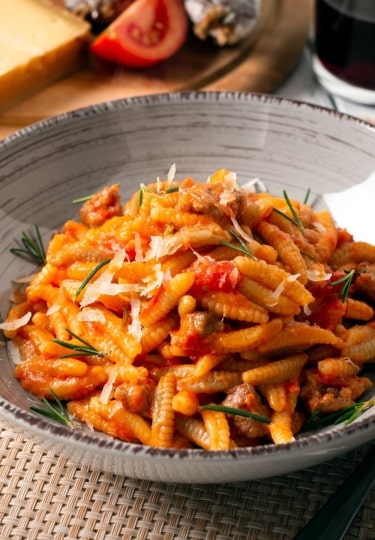Sardinian food is unique. Like a lasagna, it has layers that include Italian, African, indigenous flavors, and more.
Outstanding quality seafood is fished from the azure Mediterranean, while its rustic pantry is hearty and surprising. Invaders such as the Spanish and the early Phoenicians all added their notes to the Sardinian recipe book, and these influences you can taste in Sardinian food today.
With its mid-Mediterranean position, Sardinia’s produce, like the rest of Italy, is full of flavor.
Conditions are also excellent for grape growing, and the island has an indigenous wine list that pairs beautifully with the island’s pan-continental array of spices. Whether you’re trying spaghetti con ricci di mare at a restaurant overlooking Poetto Beach, or tasting cannonau and fiore sardo at a vineyard tour, you’ll be endlessly impressed with Sardinian food.
Porceddu
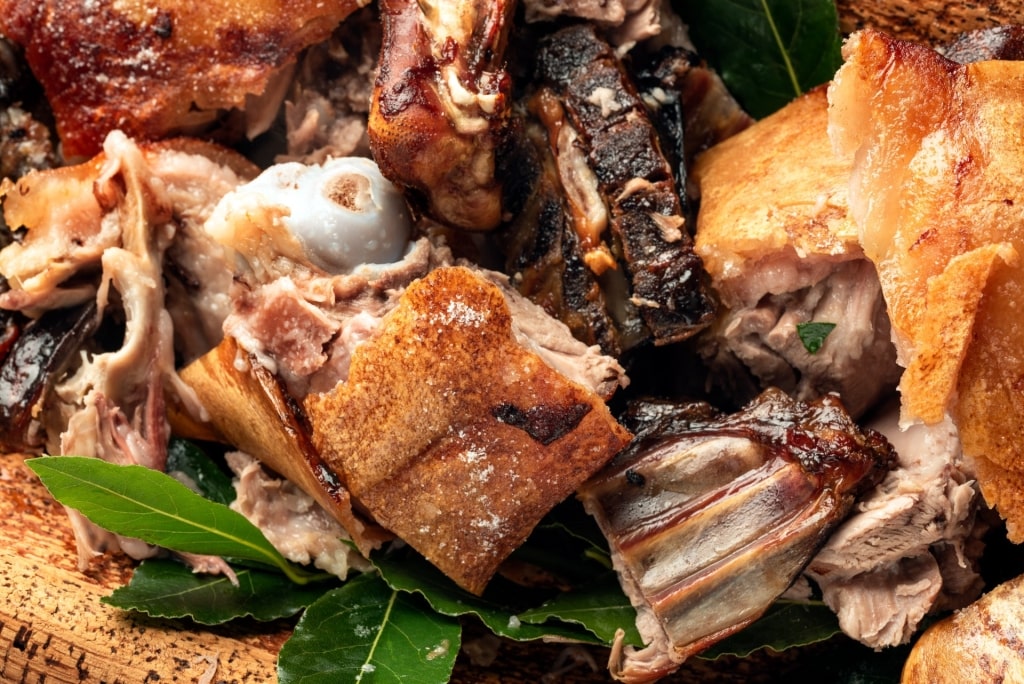
Porceddu
Porceddu is the Sardinian word for “suckling pig”. Similar to suckling pig made elsewhere in the world, this dish primarily involves a young pig being roasted whole over an open fire, or in a particularly capacious oven.
This traditional spitroast is an ancient delicacy on the island. It was a centerpiece of rituals and festivals for the Sardinians’ distant Nuraghi ancestors, their fires throwing shadows among the oaks and sending an irresistible porky fragrance into the air 10,000 years ago.
Today, the crispy skin and juicy, smoky meat of porceddu are still the centerpieces of many celebrations and gatherings on the island. Adding to the dish’s complexity are sprigs of rosemary and myrtle foraged from the shrubs that flourish in the island’s rich soil. If someone prepares porceddu for you while you’re visiting Sardinia, take it as a great compliment.
Malloreddus
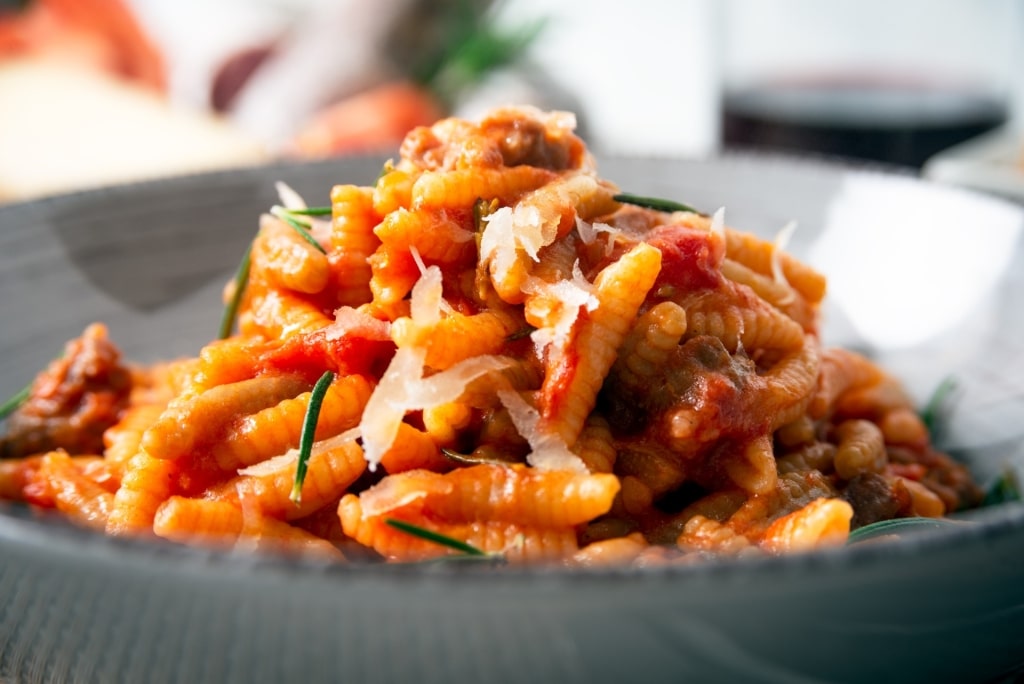
Malloreddus
Malloreddus is, to all intents and purposes, Sardinian gnocchi. However, while the mainland versions of these plump, double-carb delights contain potatoes, the Sardinian version is more streamlined. Only wheat, semolina, and water go into the preparation of malloreddus.
A dish of heavenly simplicity, it’s believed that malloreddus has its origins in the era of ancient Rome. Its current form—the ridged curls traditionally made by pressing the dough against the side of a straw basket—is a medieval-era innovation.
Malloreddus is equally good served in a simple butter and sage sauce or tumbled in a rich sausage and fennel ragu. These little morsels—the name translates as “little calves”—also hold a ceremonial role in a traditional marriage ceremony. When a newlywed wife would arrive at her husband’s house, she’d bring some homemade malloreddus.
Carpaccio de Carciofi
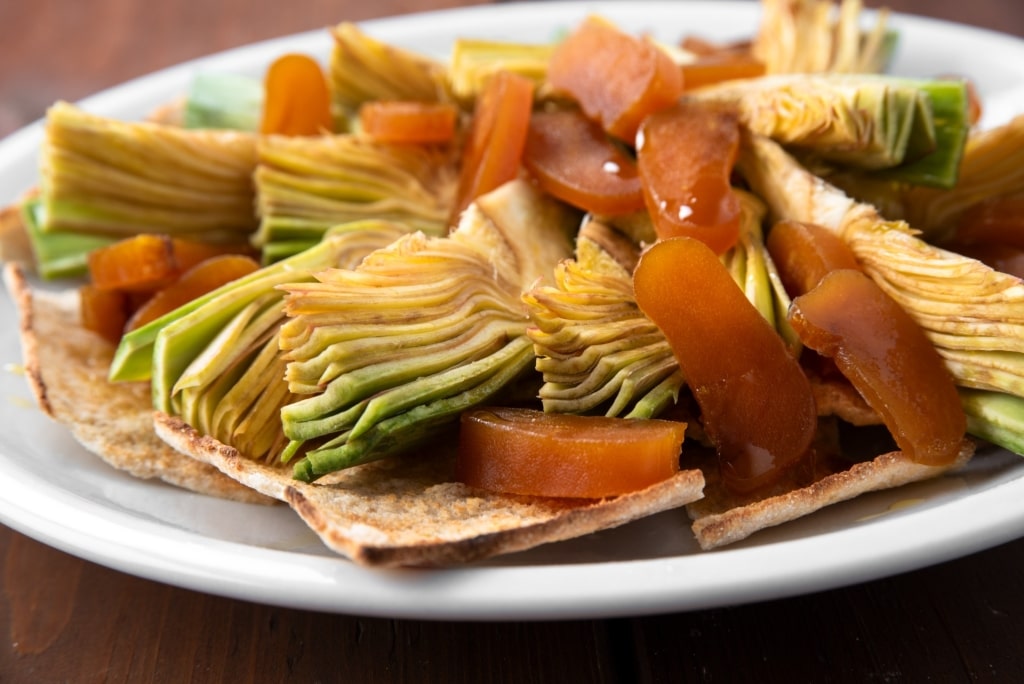
Carpaccio de carciofi
A vegetable keystone of Sardinian food, artichokes are a must-try while you’re visiting this region. The Sardinian artichoke—Carciofo Spinoso di Sardegna—looks different from the common globe-like artichokes you often find in the grocery store. The island artichoke has a more elongated look, with a vibrant purple hue visible on the bracts.
The island is one of Italy’s leading producers of artichokes, and its Valledorian artichokes, from the island’s northwest, are considered the very best. Among the many ways they’re served, perhaps the most authentically Sardinian is to eat them as thinly sliced carpaccio with a drizzle of umami-rich bottarga, the local answer to caviar, and olive oil on top.
Pane Carasau
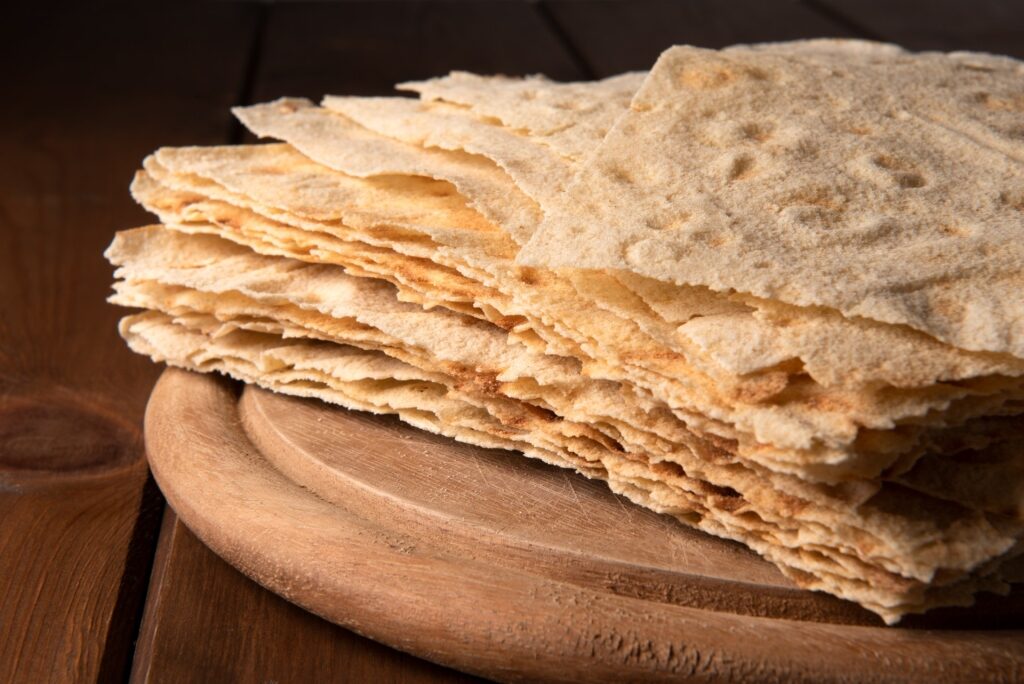
Pane carasau
A flatbread with a long history in Sardinian food, pane carasau is sometimes known by its other, poetic name “carta da musica” or “music paper”. Apparently, the flatbread dough is so thin before being baked that you could, if the inclination seized you, read sheet music through it.
Baked twice until golden and crisp, unleavened pane carasau is a filling, long-lasting snack that hard-working, Sardinian shepherds have relied on for over 3,000 years. Today, it’s a popular side dish or it can take a more central role such as in pane frattau—a Sardinian take on huevos rancheros.
Fregula
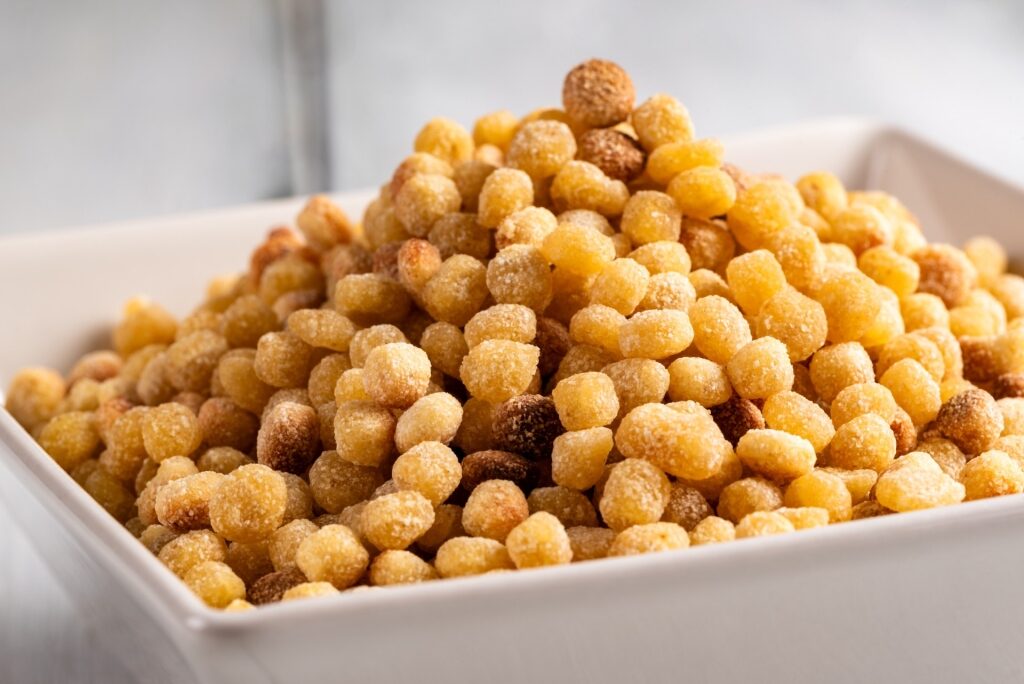
Fregula
Fregula is one of those Sardinian dishes that immediately reminds you that only 180 nautical miles south is the coast of North Africa.
Looking something like the lovechild of couscous and garbanzo beans, fregola is essentially couscous pasta—semolina flour mixed with water that is then toasted to a delicious crunchy nuttiness.
Fregula offers a popular contrasting texture in seafood dishes. You’ll find little pearls of it in your saffron-sprinkled seafood soup, or combined with shellfish in “fregula con arselle”.
Zuppa Gallurese
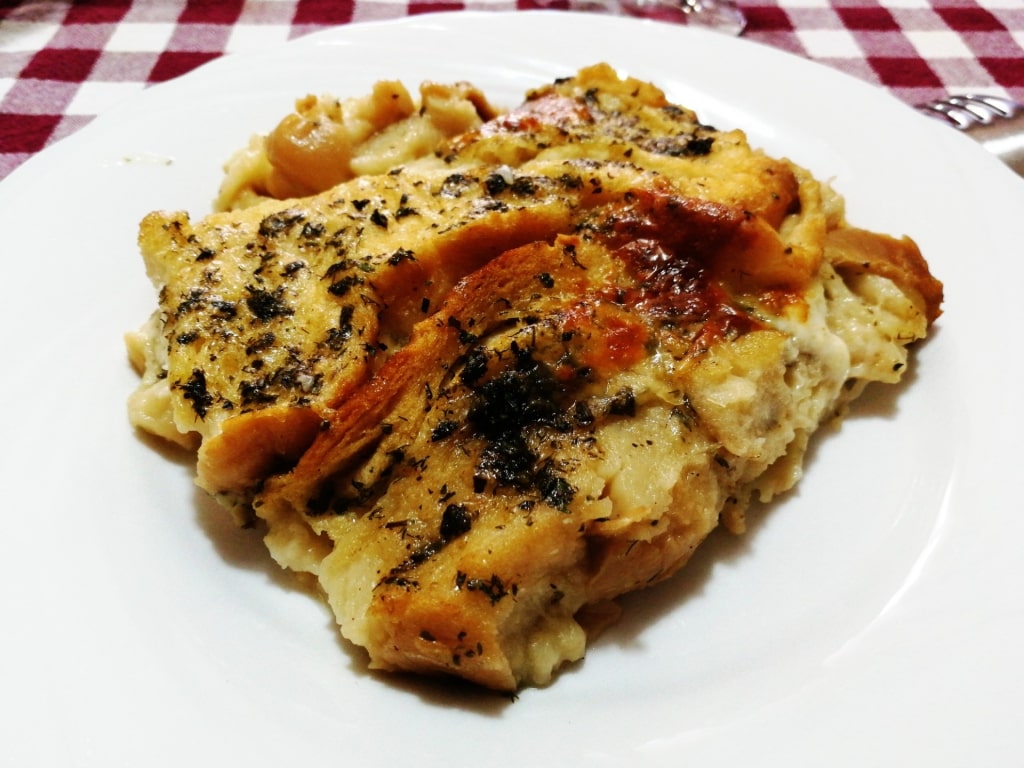
Zuppa gallurese
Not to be confused with the Italian take on English trifle, “zuppa inglese”, zuppa gallurese is instead a Sardinian dish that is an icon of the island’s cucina povera.
Pure comfort food, this peasant dish is a gooey casserole of layered bread saturated in a rich meaty broth, which has then been covered in pecorino sardo and other cheeses. Salty and lightly herbaceous, a popular variety of zuppa gallurese is often constructed from the island’s famously sheer pane carasau flatbread, creating a kind of Sardinian lasagna.
Bottarga di Muggine

Bottarga di Muggine
Bottarga di Muggine is a Sardinian delicacy that’s also known as “Mediterranean caviar”.
Bottarga is made by removing the roe sacs of either mullet or tuna. After these sacs have had any air gently removed from inside, they are salted and dried.
After up to a month and a half of drying on racks, the bottarga is ready to enjoy. Sardinians love its salty, punchy flavor, which adds an umami depth when applied in shavings onto “spaghetti con bottarga” or over their lunchtime eggs.
Spaghetti con Ricci di Mare

Spaghetti con ricci di mare
“Ricci di mare” is the Italian for sea urchins. Order spaghetti con ricci di mare at a restaurant, and you’ll receive a bowlful of spaghetti noodles sleek with the rich, briny sweetness of sea urchin roe melted into a white wine, garlic, and shallot sauce. It’s a popular plate of pasta from southern Cagliari right up northerly Alghero.
In this Sardinian dish, you can taste the quality of the local urchins, thriving in the clean seas. Once you’ve tried a plateful of spaghetti con ricci di mare, paired with a chilled local Vermentino, it’ll change how you regard the spiky, mauve-hued urchins lurking in Sardinia’s turquoise shallows.
Pecorino Sardo
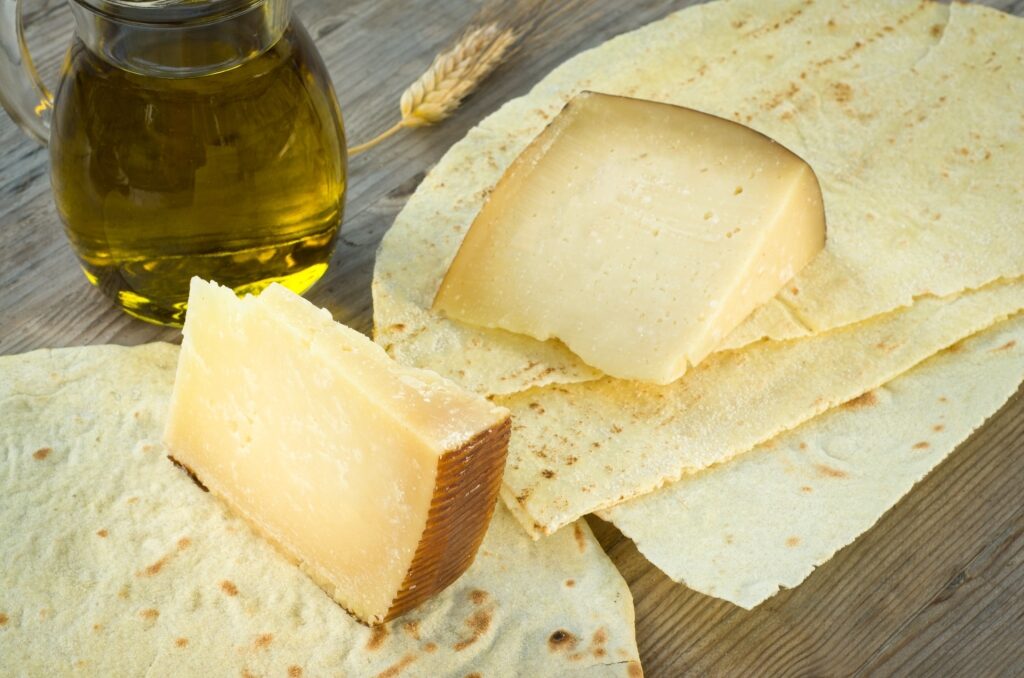
Pecorino sardo
Sardinia’s oak-forested, mountainous interior is home to the Sarda—the island’s distinctive and hardy breed of sheep. Believed to be descended from the Sardinian wild mouflon, the Sarda has scaled the rocky gorges seeking the lushest grass on this beautiful island for over 4,000 years.
You’ll see these tough, tousled bovines all around the island. Almost as numerous are the wheels of pecorino sardo—the island’s PDO-protected raw sheep’s milk cheese. For those familiar with the more well-known pecorino romano from Lazio, you’ll find the Sardinian version less salty and creamier, especially the younger “dolce” variety.
This cheese goes on everything in Sardinia: shaved over pasta, crumbled into salads, and melted on casseroles. It’s also beautiful served in thin, pale triangles and drizzled with some of the island’s chestnut honey.
Casu Marzu
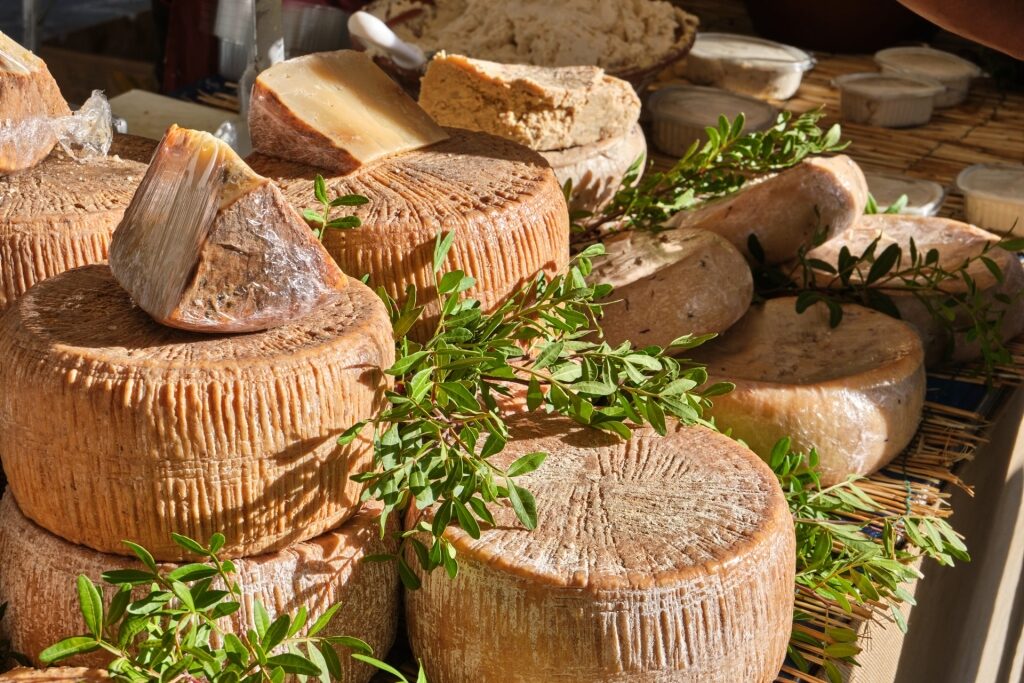
Casu marzu
Another version of pecorino sardo is casu marzu. Think of it as pecorino that has crossed over to the dark side. This cheese is not for the squeamish.
Casu marzu translates as “rotten cheese”. Another name for it is “the cheese that walks”. To produce it, a wheel of pecorino sardo is left over-long to age. As it begins to ferment, the so-called “cheese flies” lay their eggs on the pecorino.
When the maggots hatch, they feed on the pecorino, transforming the hard cheese into a creamy, spicy mush with a powerful ammonia tang.
Casu marzu and a few other Italian cheeses with similar insect interventions are illegal in the EU due to possible health risks. This hasn’t stopped the Sardinians, who have been enjoying this acquired taste for centuries and continue to do so. However, it is rare. If you encounter it, it will probably be at a celebration in a smaller rural community.
Fiore Sardo

Fiore sardo
Fiore Sardo is the smoked version of Sardinia’s beloved raw sheep’s milk cheese, pecorino sardo. Traditionally smoked over an open fire, the tangy, salty flavor of this hard cheese is made all the more irresistible by the complexity imbued by the fragrant oak or olive wood burnt during the smoking process.
Fiore Sardo appears in Sardinian food in much the same way as the unsmoked version. It’s also delicious on its own as part of a Sardinian cheeseboard.
Sebadas
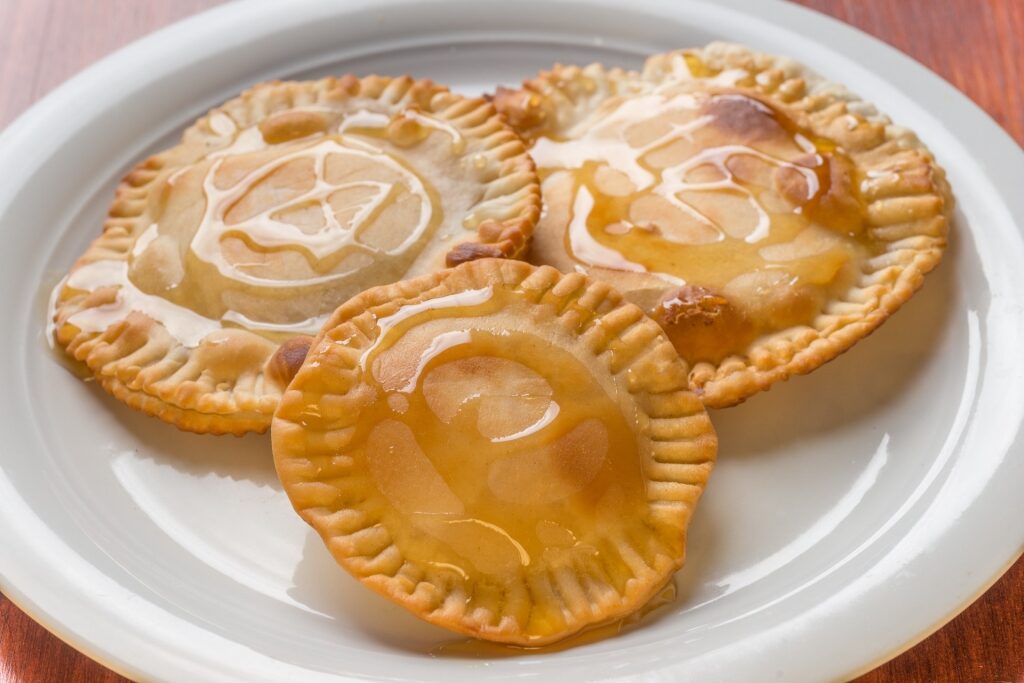
Sebadas
Demonstrating just how deeply entwined pecorino is in almost all aspects of Sardinian cuisine, it even makes an appearance as part of the island’s most famous sweet treat.
Sebadas, or “seadas” is a fried pie made from semolina flour that contains a lemon-zested cheese filling. Deep fried until crisp and golden, it’s finished off with a sticky sweet drizzle of flavorsome local honey.
As prolific as tiramisu when it comes to appearances on the Sardinian dessert tray, seadas can have different fillings. Some have orange zest or herbs inside, or fresh ricotta in place of salty pecorino.
Seadas’ appearance, like little circular fried pies with crimped edges, is a reminder of their origins as a portable lunch option for shepherds, much like pasties in the UK or the empanada in Latin America. Originally a way for shepherds to use up leftover pecorino, seadas evolved to become the celebrated Sardinian dessert it is today.
Corbezzolo Honey
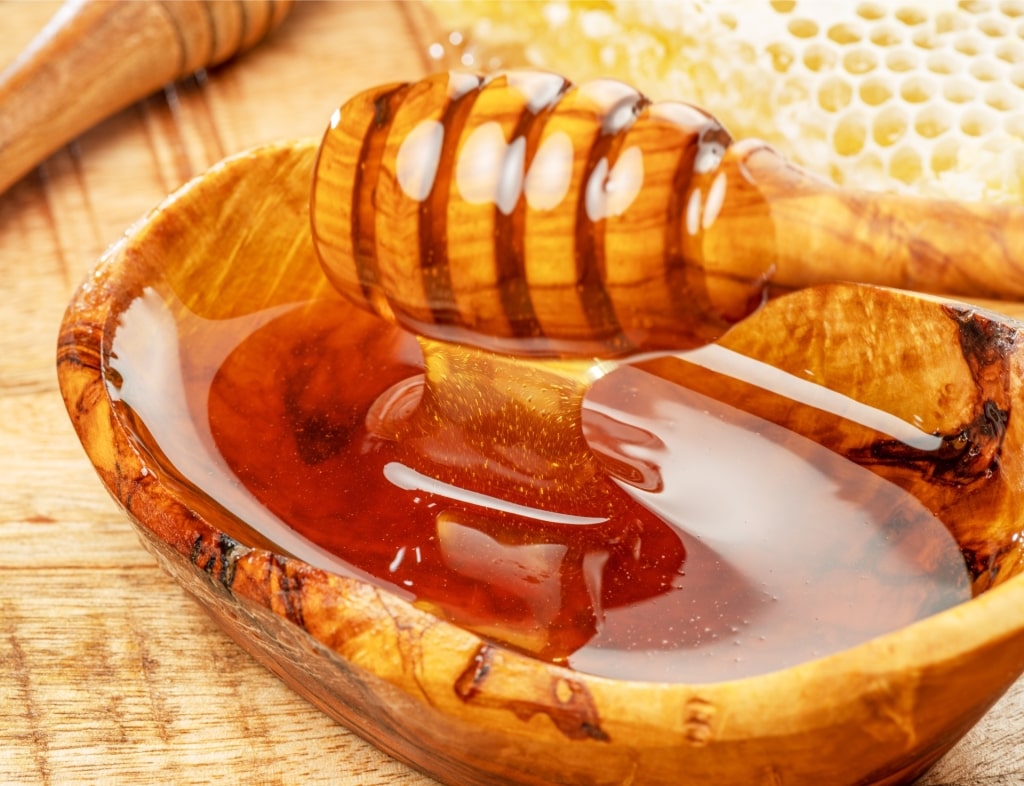
Honey
Whether in golden puddles on cheese plates, gilding desserts, or in small pots at a breakfast buffet, you’ll find that Sardinia has a tasty selection of honey varieties to try.
Perhaps the most distinctive is the island’s corbezzolo honey. While walking along the pine-scented paths leading to many of Sardinia’s glorious beaches, you’ll often pass beneath the canopy of its many strawberry trees with their distinctive bunches of red and yellow fruit. Corbezzolo honey is created by bees using nectar from these pretty trees.
Be sure to taste before slathering it onto your toast. Corbezzolo honey has a very distinctive, bitter flavor, offering notes of licorice, leather, and coffee, perfect for pairing with your frothy cappuccino.
Culurgiones
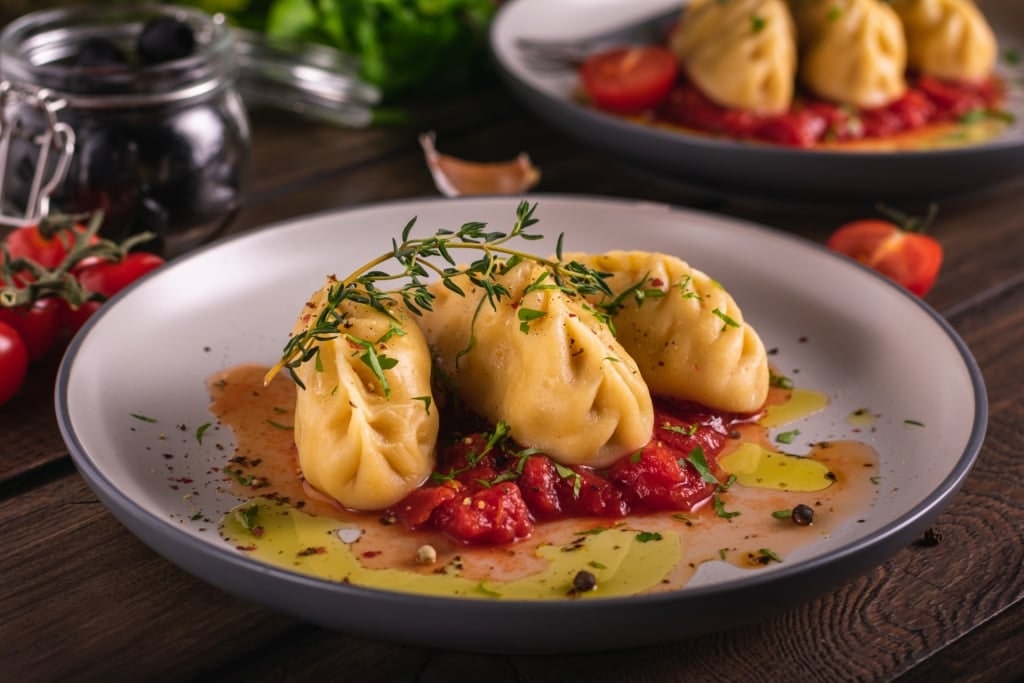
Culurgiones
Culurgiones are delicious stuffed pasta. This dumpling-pasta hybrid originally hails from the Ogliastra region in Sardinia’s rugged east, where the sweet seadas dessert was also created.
Filled with a fragrant, hearty puree of potatoes, cheese, garlic, and mint, although fillings do vary, culurgiones are often served with a simple tomato sauce. The tang of the tomato offers a vibrant contrast to the hearty flavors of these comfort food parcels.
Before you devour your culurgiones, pause to admire their construction, traditionally folded and pinched to mimic an ear of wheat.
Salsiccia Sarda
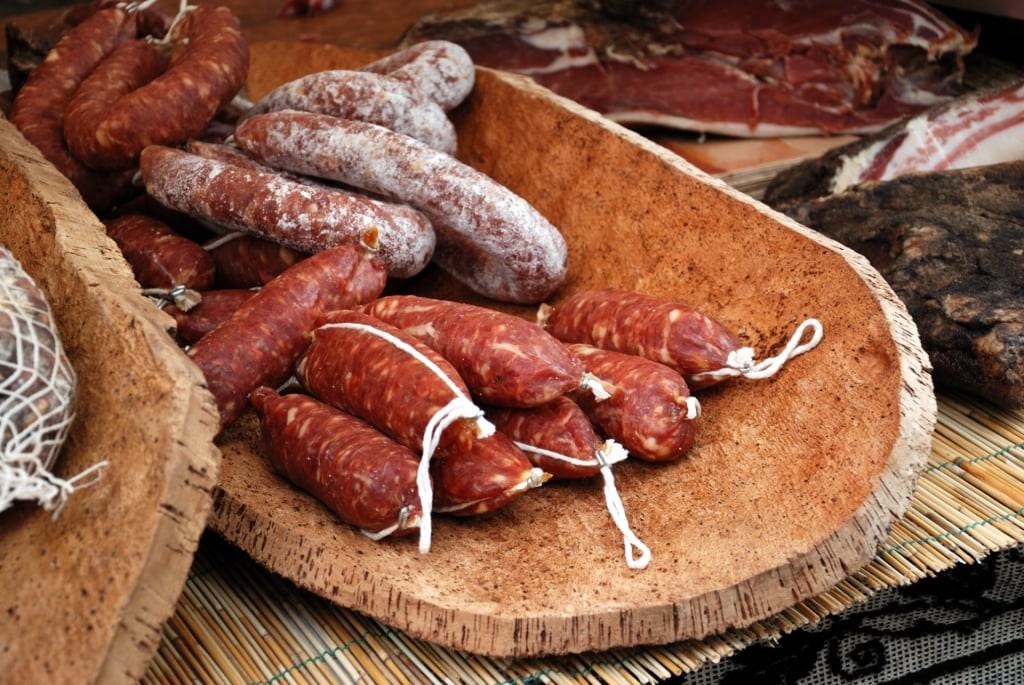
Salsiccia sarda
In practically every Italian region, you’ll find a cured pork sausage made with local ingredients that has a distinctive flavor, even from other cured pork sausages hung to dry just over the regional border.
In Sardinia, they have salsiccia sarda. A mainstay of Sardinian food, you’ll find its coarse-ground slices on pizzas, paired with fiore sardo as antipasti, and often just served grilled on its own.
The standard version is simply seasoned with black pepper, however, salsiccia sarda also comes smoked, herbaceous, or with a touch of spice. Perhaps the one most redolent of Sardinia’s hinterland is the variety imbued with a gentle licorice flavor supplied by fennel seeds from the Marmilla region.
A few slices of this paired with a glass of Sardinian cannonau while a sunset burns over Cagliari is a fine precursor to an evening in the capital.
Wine
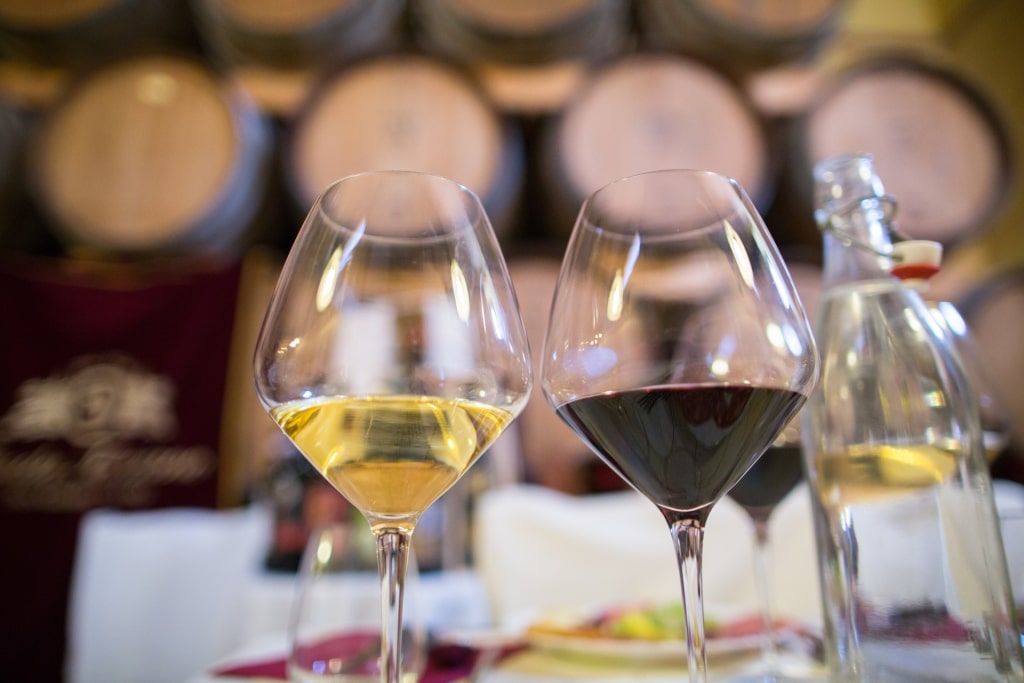
Wine
Sardinian food would not be as delectable as it is without the incredible selection of the island’s homegrown wines.
With grape varieties both indigenous and those delivered on the trade winds, Sardinian wines boast an enticing range. The preeminent variety—and only DOCG—is Vermentino, its flavor profile likened to Sauvignon Blanc. This slightly saline and fruity white is wonderful served with any of Sardinia’s flavorsome seafood dishes.
Much of the credit for the cultivation of the Sardinian wine scene lands in the laps of the ancient Phoenicians. Both the zesty white wine, Nuragus, and the fortified Vernaccia were brought to Sardinia in amphorae stacked in their ships’ bellies.
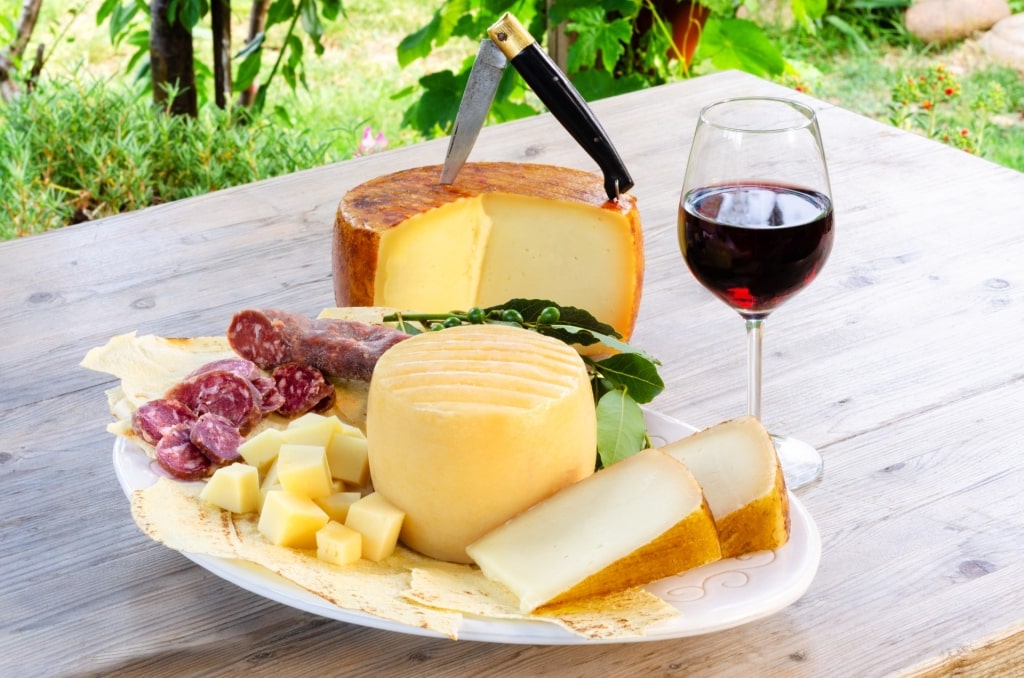
Wine
Red wine lovers are also well served. Sardinian cannonau is a distinctive, spicy take on grenache, perfect when sipped alongside a smoky plateful of juicy porcheddu.
Read: Best Food Cities in Italy

Cagliari
Experience authentic Sardinian dishes and more on a cruise vacation to Italy. Browse Celebrity’s Sardinia cruise itineraries today and plan your gourmet adventure.
